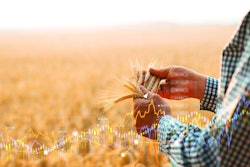
New report from Rabobank focuses on key North American agribusiness sectors
Inflation will remain a problem in 2023, with feed ingredients increasingly scarce and prices high, according to Rabobank’s North American Agribusiness Review for October.
Below are some of Rabobank’s findings for key agribusiness sectors.
Feed, feed ingredients
Feed: Feed mills continue to buy soybean meal despite higher prices, with demand from animal feed up 2.4% from the same period last year. Prices for dried distillers grains (DDGs) are higher, making DDGs a more expensive ingredient than soybean meal from a crude protein level. Feed grain substitutes – including barley, oats, rye, sorghum and wheat – are scarce, which means the potential to offset high corn prices for feed rations is low.
Corn: Lower planted area, yields and ending stocks support corn prices, but slow export market and Mississippi River challenges will likely temper demand. Low Mississippi River levels are slowing exports in an already slow environment as the number of grain barges are limited.
“This paints a difficult outlook for the export market due to a slow start of the year, at a time that harvest is at full speed,” the report said.
Soybeans: The U.S. could see the second-tightest ending stock-to-use ratio on record, with drought pushing yields below trend. As with the corn market, low water levels on the Mississippi River have aggravated agricultural export channels; the soybean crop has been leaving the country at its slowest pace since 2013.
“If we learned anything from 2013, it’s that transportation disruptions weigh more heavily on whole beans than on meal or oil, which could trigger a repeat of high surface crush margins in the Midwest,” the report said.
Wheat: Uncertainty surrounds the wheat market, with factors including the war in Ukraine and weather. Global wheat stocks are in decline for the third consecutive year.
Proteins
Poultry: Chicken prices have fallen sharply as more availability has saturated the market. Prices are expected to fall until volumes stabilize. Ready-to-cook chicken production surged in late September, due to higher slaughter levels and a notable gain in weights. August chicken exports were down slightly in volume, but up 18.6% in value.
Pork: Hog prices are lower seasonally but supplies remain below packers’ needs, with hog slaughter down 1.6% from year-ago levels. Pork production was nearly flat in the third quarter and is expected to be down 1.5% in the fourth quarter. August pork export volumes and values were down 3.4% and 2.4%, respectively, but U.S. exports are expected to remain competitive in 2023 due to declines in global hog production.
Cattle: More than 60% of the U.S. beef cow herd is battling moderate or worse drought conditions, and the beef cow herd is on pace to see a record annual culling rate near 13.5%. Higher feed costs are stifling cattle producer optimism as feed costs are pushing fed cattle breakeven sales prices higher.










